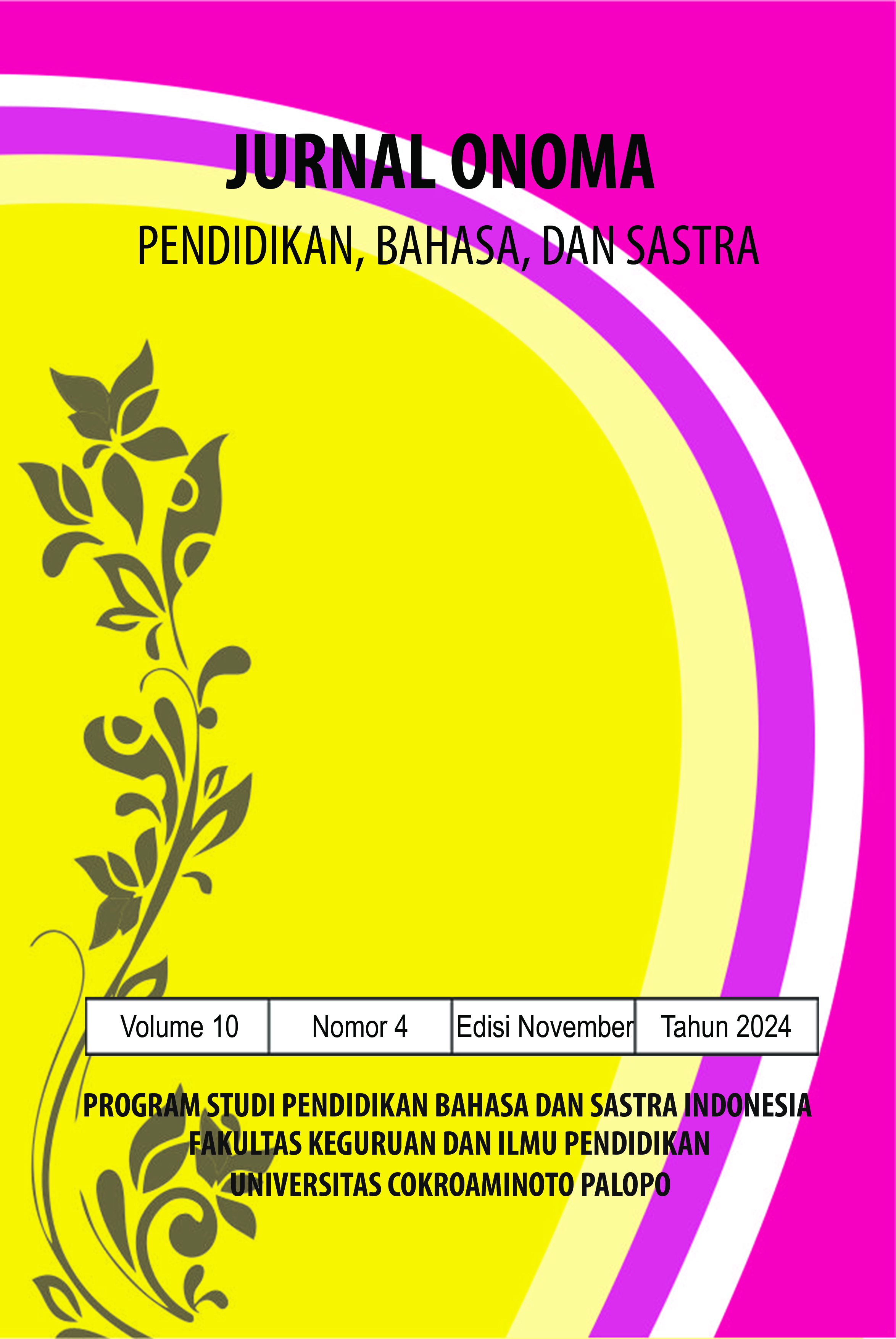Bentuk Ungkapan Tabu dan Makna Ikonis pada Makanan Tradisi Adat Pranikah Suku Dayak Maanyan
https://doi.org/10.30605/onoma.v10i4.4726
Keywords:
antropolinguistik, pranikah Dayak Maanyan, makna ikonisAbstract
Penelitian ini bertujuan untuk mendeskripsikan bentuk ungkapan tabu dan makna ikonis pada makanan saat tradisi pranikah suku Dayak Maanyan dengan tujuan untuk mendeskripsikan bentuk ikonis Daya dan mendeskripsikan makna ikonis pada kuliner khas Dayak Maanyan Kalimantan. Penelitian ini dikaji menggunakan kajian antropolinguistik. Jenis penelitian ini adalah deskriptif kualitatif. Metode dalam penelitian adalah metode wawancara (etnografi). Data dalam penelitian berupa gambar makanan kuliner khas Dayak Maanyan. Sumber data yaitu masyarakat dan mahasiswa yang memiliki pengetahuan mengenai kuliner khas Dayak Maanyan Kalimantan. Pengumpulan data penelitian melalui dokumentasi dan catat. Teknik analisis data dilakukan dengan tahapan mengidentifikasi data hasil temuan, mengklasifikasikan data tuturan berupa gambar, menginterpretasikan data dan menyimpulkan. Temuan dari penelitian ini berkontribusi pada bidang linguistik, studi budaya, dan antropologi. Dengan mendalami signifikansi nama-nama makanan saat tradisi pranikah suku Dayak Maanyan, penelitian ini akan memperkaya pemahaman tentang lanskap tradisi adat pranikah suku Dayak Maanyan dan hubungannya dengan sosial budaya yang dapat diketahui masyarakat umum.
Downloads
References
Listiani, F., & Rahardi, R. (2020). Iconic Meanings of Flora Names in Dipasena as the Shrimp Aquaculture Area: Envirolinguistic Study. LINGUA DIDAKTIKA: Jiurnal Bahasa dan Pembelajaran Bahasa (Terakreditasi Sinta 3), 14(1), 87–98. https://doi.org/10.24036/ld.v1 4i1.42133 DOI: https://doi.org/10.24036/ld.v14i1.109040
Carrol, John B. (ed.).1969. Language, Thought, and Reality: Selected Writings of Benja- min Lee Whorf. Cambridge: The M.I.T. Press.
Danesi, Marcel. 2004. A Basic Course in An- thropological Linguistics. Toronto: Ca- nadian Scholars’ Press.
Duranti, Alessandro (ed.).2001. Linguistic An- thropology. Massachusetts: Blacwell.
Duranti, Alessandro (ed.). 2004. A Companion to Linguistic Anthropology. Malden: Blackwell. DOI: https://doi.org/10.1111/b.9781405144308.2005.00002.x
Alcoff, L.M. & Mendieta, E. (Eds). (2000). Identities: Race,Class, Gender, Blagckwell Publishing.
and Nationality.UK: Bentley, A. (2007). Culinary Other. London: Polity Press.
Bhabha, H.K. (1994). The Location of Culture, London: Routledge.
Castel, M. (1997). The Power of Identity.Oxford: Blackwell Publishing.
Hall, S. (1994). The Question of Cultural Identity. : London: Sage Publication
C. Wasson, “Linguistic anthropology,” Handb. Bus. Discourse, no. January, pp. 194–212, 200 DOI: https://doi.org/10.1515/9780748631834-022
Chemie Int. Ed. 6(11), 951–952., vol. 13, no. April, pp. 15–38, 1967. DOI: https://doi.org/10.1002/anie.196709511
Suparman, S. (2024). Konteks Budaya Perkawinan Masyarakat Bugis Luwu (Kajian Antropolinguistik). DEIKTIS: Jurnal Pendidikan Bahasa dan Sastra, 4(3), 233-238. DOI: https://doi.org/10.53769/deiktis.v3i4.559
M. Al Farobi, M. A. Aminullah, T. Mulyanti, U. I. N. Maulana, and M. Ibrahim, “Tabu Ungkapan Dalam Budaya Bahasa Jawa Ngapak Banyumasan,” vol. 7, no. 2, pp. 77–82, 2022. A. H. Pulungan, “Kajian Etnolinguistik terhadap Peribahasa dalam Bahasa Indonesia: Sebuah Tinjauan Pragmatic Force (Daya Pragmatik),” Univ. Negeri Medan, pp. 10–28, 2016.C. Wasson, “Linguistic anthropology,” Handb. Bus. Discourse, no. January, pp. 194–212, 2000 DOI: https://doi.org/10.47028/j.risenologi.2022.72.310
Downloads
Published
How to Cite
License
In submitting the manuscript to the journal, the authors certify that:
- They are authorized by their co-authors to enter into these arrangements.
- The work described has not been formally published before, except in the form of an abstract or as part of a published lecture, review, thesis, or overlay journal.
- That it is not under consideration for publication elsewhere,
- That its publication has been approved by all the author(s) and by the responsible authorities – tacitly or explicitly – of the institutes where the work has been carried out.
- They secure the right to reproduce any material that has already been published or copyrighted elsewhere.
- They agree to the following license and copyright agreement.
License and Copyright Agreement
Authors who publish with Onoma Journal: Education, Languages??, and Literature agree to the following terms:
- Authors retain copyright and grant the journal right of first publication with the work simultaneously licensed under Creative Commons Attribution License (CC BY 4.0) that allows others to share the work with an acknowledgment of the work's authorship and initial publication in this journal.
- Authors are able to enter into separate, additional contractual arrangements for the non-exclusive distribution of the journal's published version of the work (e.g., post it to an institutional repository or publish it in a book), with an acknowledgment of its initial publication in this journal.
- Authors are permitted and encouraged to post their work online (e.g., in institutional repositories or on their website) prior to and during the submission process, as it can lead to productive exchanges, as well as earlier and greater citation of published work.

















